Environmental Impact Assessment Study for Residential House Project
VerifiedAdded on 2023/06/09
|21
|4092
|67
Report
AI Summary
This Environmental Impact Assessment (EIA) report examines the potential environmental impacts of a proposed residential house project located on Gorman Street, Marrickville NSW 2204. The report outlines the project's scope, including site clearing, excavation, construction, and finishing works. It identifies potential adverse effects during construction, operation, and decommissioning phases, such as land use conflicts, pollution, noise, and waste generation. Mitigation measures are proposed to address these impacts, encompassing project design modifications, responsible sourcing of raw materials, noise and dust control, worker safety protocols, waste management strategies, and water conservation practices. The report also provides a project background, objectives, and scope, including the assessment of biophysical and socio-economic impacts, and outlines environmental management and monitoring plans. The EIA aims to ensure sustainable development by integrating environmental concerns into all construction activities and providing a basis for decision-making and monitoring throughout the project lifecycle.
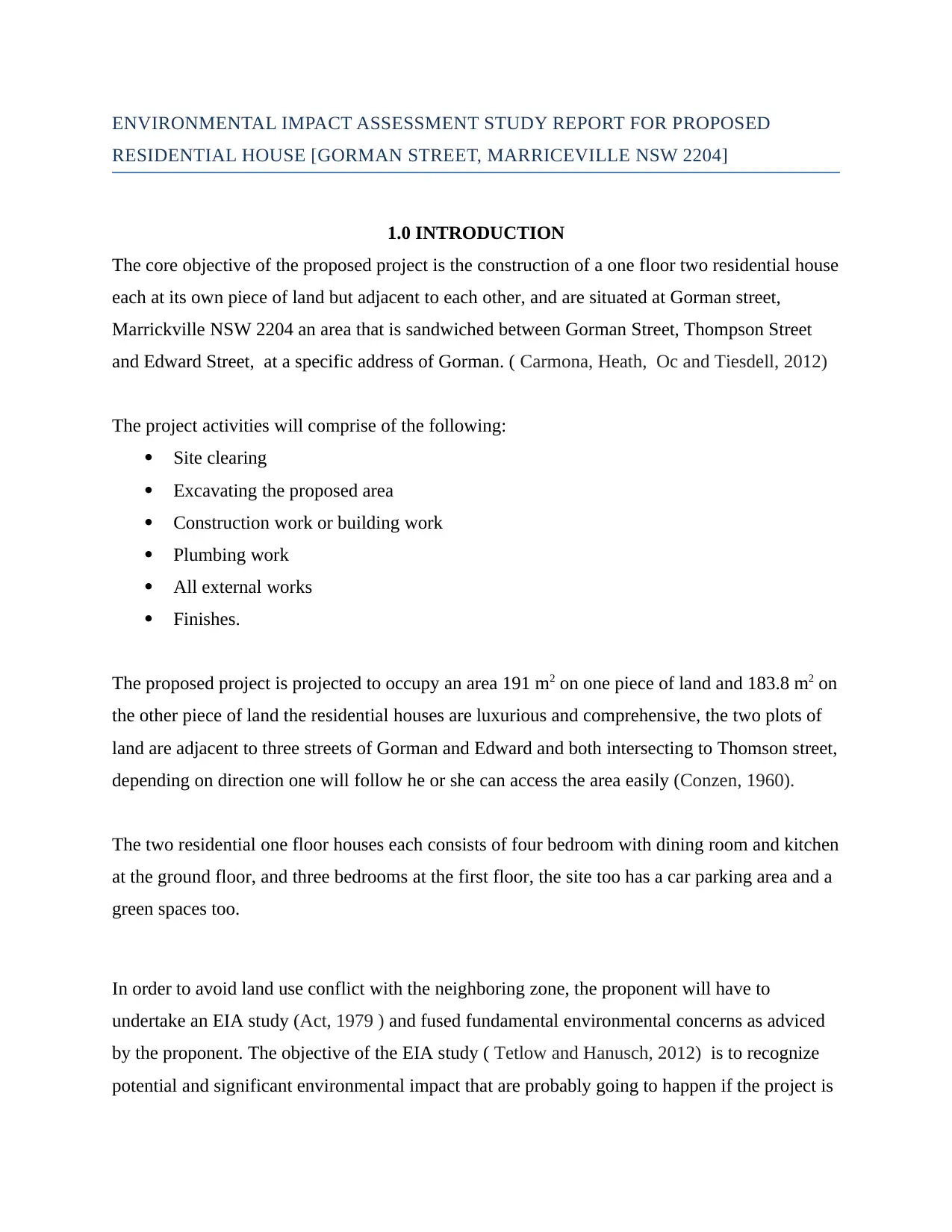
ENVIRONMENTAL IMPACT ASSESSMENT STUDY REPORT FOR PROPOSED
RESIDENTIAL HOUSE [GORMAN STREET, MARRICEVILLE NSW 2204]
1.0 INTRODUCTION
The core objective of the proposed project is the construction of a one floor two residential house
each at its own piece of land but adjacent to each other, and are situated at Gorman street,
Marrickville NSW 2204 an area that is sandwiched between Gorman Street, Thompson Street
and Edward Street, at a specific address of Gorman. ( Carmona, Heath, Oc and Tiesdell, 2012)
The project activities will comprise of the following:
Site clearing
Excavating the proposed area
Construction work or building work
Plumbing work
All external works
Finishes.
The proposed project is projected to occupy an area 191 m2 on one piece of land and 183.8 m2 on
the other piece of land the residential houses are luxurious and comprehensive, the two plots of
land are adjacent to three streets of Gorman and Edward and both intersecting to Thomson street,
depending on direction one will follow he or she can access the area easily (Conzen, 1960).
The two residential one floor houses each consists of four bedroom with dining room and kitchen
at the ground floor, and three bedrooms at the first floor, the site too has a car parking area and a
green spaces too.
In order to avoid land use conflict with the neighboring zone, the proponent will have to
undertake an EIA study (Act, 1979 ) and fused fundamental environmental concerns as adviced
by the proponent. The objective of the EIA study ( Tetlow and Hanusch, 2012) is to recognize
potential and significant environmental impact that are probably going to happen if the project is
RESIDENTIAL HOUSE [GORMAN STREET, MARRICEVILLE NSW 2204]
1.0 INTRODUCTION
The core objective of the proposed project is the construction of a one floor two residential house
each at its own piece of land but adjacent to each other, and are situated at Gorman street,
Marrickville NSW 2204 an area that is sandwiched between Gorman Street, Thompson Street
and Edward Street, at a specific address of Gorman. ( Carmona, Heath, Oc and Tiesdell, 2012)
The project activities will comprise of the following:
Site clearing
Excavating the proposed area
Construction work or building work
Plumbing work
All external works
Finishes.
The proposed project is projected to occupy an area 191 m2 on one piece of land and 183.8 m2 on
the other piece of land the residential houses are luxurious and comprehensive, the two plots of
land are adjacent to three streets of Gorman and Edward and both intersecting to Thomson street,
depending on direction one will follow he or she can access the area easily (Conzen, 1960).
The two residential one floor houses each consists of four bedroom with dining room and kitchen
at the ground floor, and three bedrooms at the first floor, the site too has a car parking area and a
green spaces too.
In order to avoid land use conflict with the neighboring zone, the proponent will have to
undertake an EIA study (Act, 1979 ) and fused fundamental environmental concerns as adviced
by the proponent. The objective of the EIA study ( Tetlow and Hanusch, 2012) is to recognize
potential and significant environmental impact that are probably going to happen if the project is
Paraphrase This Document
Need a fresh take? Get an instant paraphrase of this document with our AI Paraphraser
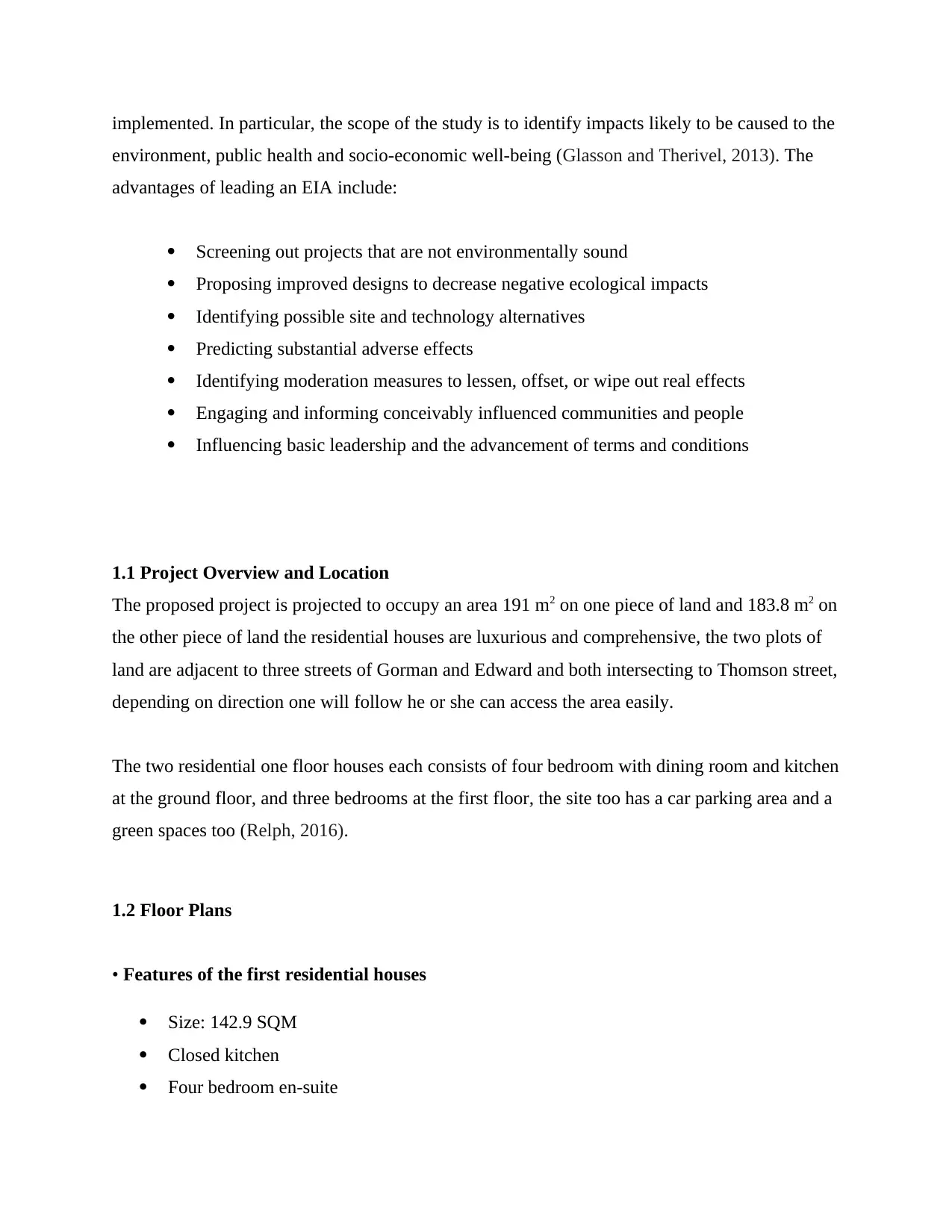
implemented. In particular, the scope of the study is to identify impacts likely to be caused to the
environment, public health and socio-economic well-being (Glasson and Therivel, 2013). The
advantages of leading an EIA include:
Screening out projects that are not environmentally sound
Proposing improved designs to decrease negative ecological impacts
Identifying possible site and technology alternatives
Predicting substantial adverse effects
Identifying moderation measures to lessen, offset, or wipe out real effects
Engaging and informing conceivably influenced communities and people
Influencing basic leadership and the advancement of terms and conditions
1.1 Project Overview and Location
The proposed project is projected to occupy an area 191 m2 on one piece of land and 183.8 m2 on
the other piece of land the residential houses are luxurious and comprehensive, the two plots of
land are adjacent to three streets of Gorman and Edward and both intersecting to Thomson street,
depending on direction one will follow he or she can access the area easily.
The two residential one floor houses each consists of four bedroom with dining room and kitchen
at the ground floor, and three bedrooms at the first floor, the site too has a car parking area and a
green spaces too (Relph, 2016).
1.2 Floor Plans
• Features of the first residential houses
Size: 142.9 SQM
Closed kitchen
Four bedroom en-suite
environment, public health and socio-economic well-being (Glasson and Therivel, 2013). The
advantages of leading an EIA include:
Screening out projects that are not environmentally sound
Proposing improved designs to decrease negative ecological impacts
Identifying possible site and technology alternatives
Predicting substantial adverse effects
Identifying moderation measures to lessen, offset, or wipe out real effects
Engaging and informing conceivably influenced communities and people
Influencing basic leadership and the advancement of terms and conditions
1.1 Project Overview and Location
The proposed project is projected to occupy an area 191 m2 on one piece of land and 183.8 m2 on
the other piece of land the residential houses are luxurious and comprehensive, the two plots of
land are adjacent to three streets of Gorman and Edward and both intersecting to Thomson street,
depending on direction one will follow he or she can access the area easily.
The two residential one floor houses each consists of four bedroom with dining room and kitchen
at the ground floor, and three bedrooms at the first floor, the site too has a car parking area and a
green spaces too (Relph, 2016).
1.2 Floor Plans
• Features of the first residential houses
Size: 142.9 SQM
Closed kitchen
Four bedroom en-suite
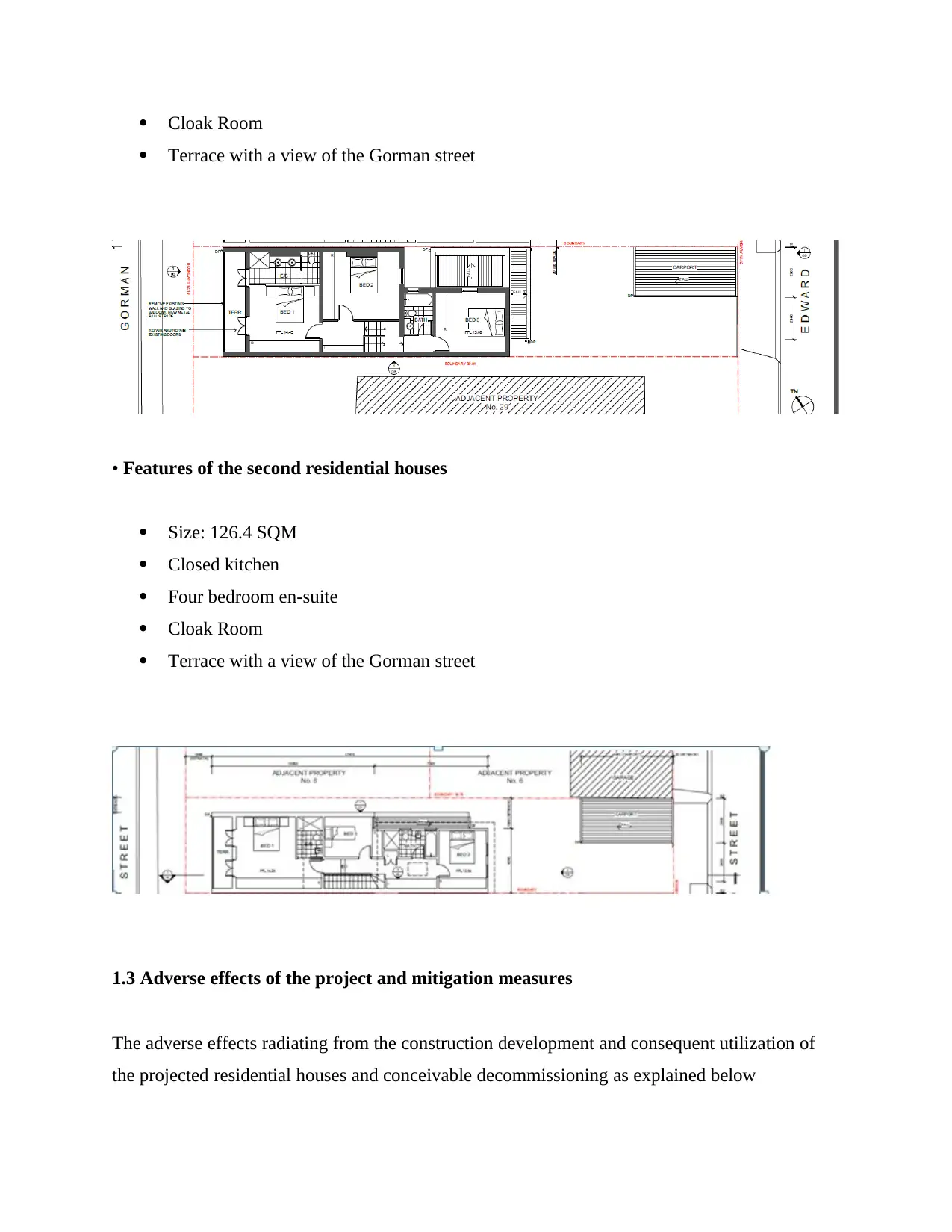
Cloak Room
Terrace with a view of the Gorman street
• Features of the second residential houses
Size: 126.4 SQM
Closed kitchen
Four bedroom en-suite
Cloak Room
Terrace with a view of the Gorman street
1.3 Adverse effects of the project and mitigation measures
The adverse effects radiating from the construction development and consequent utilization of
the projected residential houses and conceivable decommissioning as explained below
Terrace with a view of the Gorman street
• Features of the second residential houses
Size: 126.4 SQM
Closed kitchen
Four bedroom en-suite
Cloak Room
Terrace with a view of the Gorman street
1.3 Adverse effects of the project and mitigation measures
The adverse effects radiating from the construction development and consequent utilization of
the projected residential houses and conceivable decommissioning as explained below
⊘ This is a preview!⊘
Do you want full access?
Subscribe today to unlock all pages.

Trusted by 1+ million students worldwide
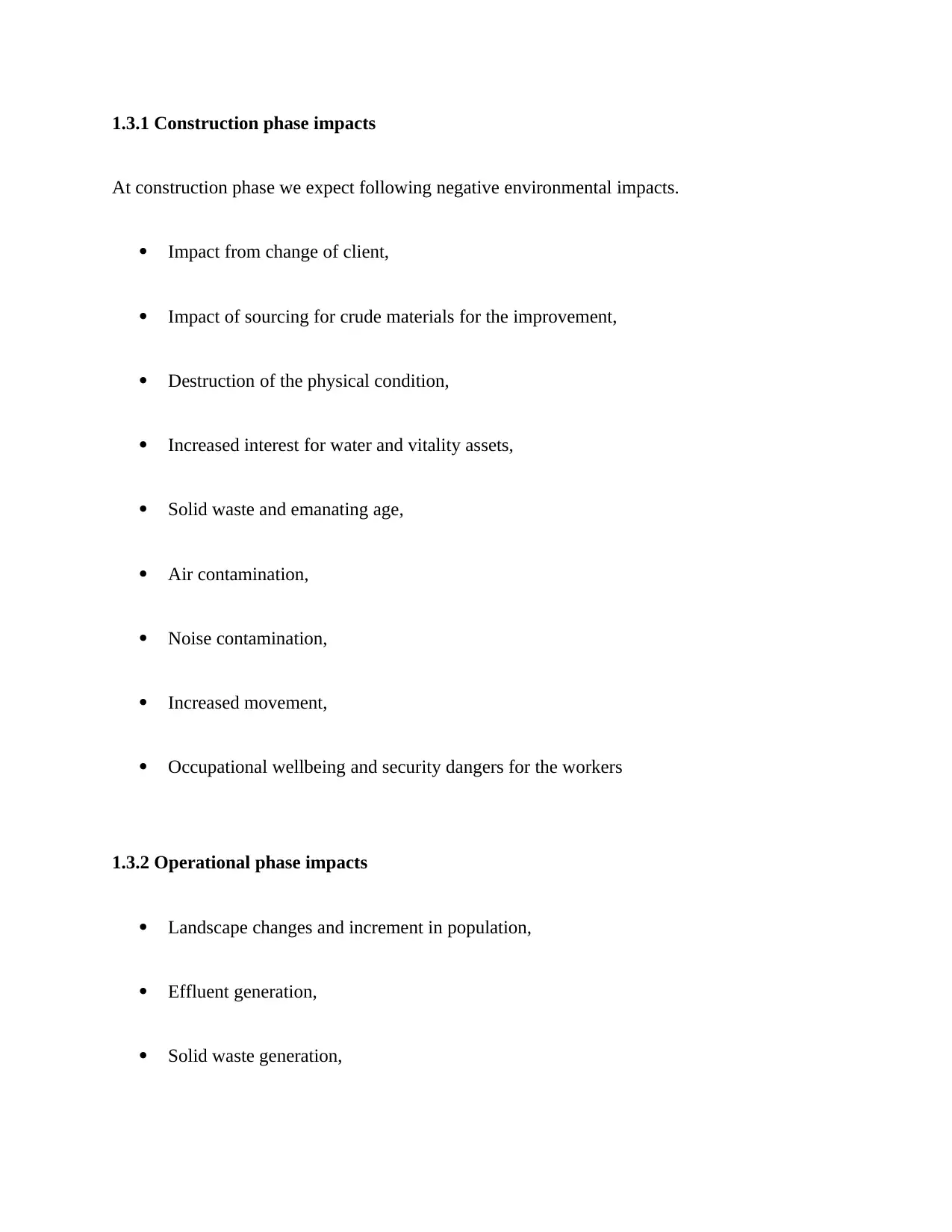
1.3.1 Construction phase impacts
At construction phase we expect following negative environmental impacts.
Impact from change of client,
Impact of sourcing for crude materials for the improvement,
Destruction of the physical condition,
Increased interest for water and vitality assets,
Solid waste and emanating age,
Air contamination,
Noise contamination,
Increased movement,
Occupational wellbeing and security dangers for the workers
1.3.2 Operational phase impacts
Landscape changes and increment in population,
Effluent generation,
Solid waste generation,
At construction phase we expect following negative environmental impacts.
Impact from change of client,
Impact of sourcing for crude materials for the improvement,
Destruction of the physical condition,
Increased interest for water and vitality assets,
Solid waste and emanating age,
Air contamination,
Noise contamination,
Increased movement,
Occupational wellbeing and security dangers for the workers
1.3.2 Operational phase impacts
Landscape changes and increment in population,
Effluent generation,
Solid waste generation,
Paraphrase This Document
Need a fresh take? Get an instant paraphrase of this document with our AI Paraphraser
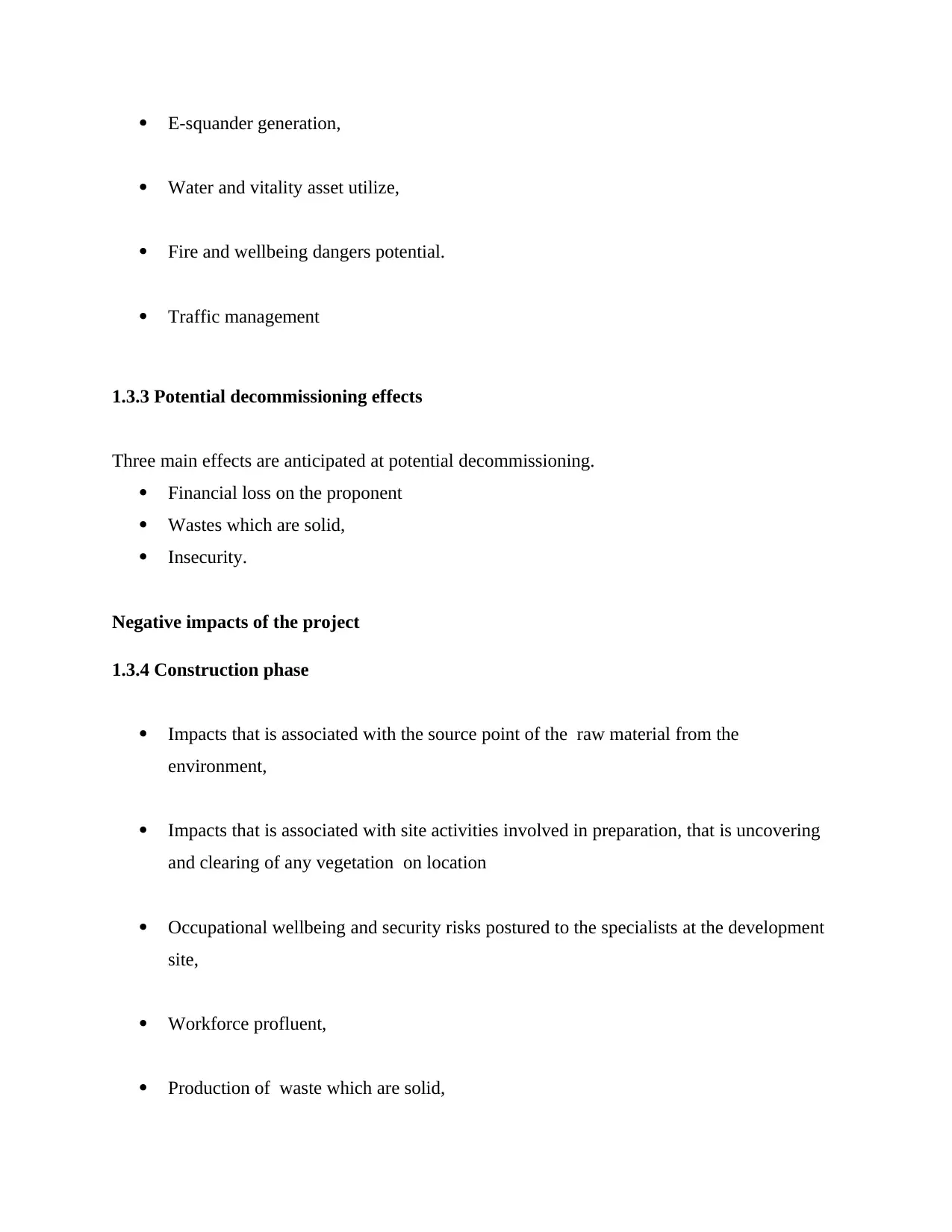
E-squander generation,
Water and vitality asset utilize,
Fire and wellbeing dangers potential.
Traffic management
1.3.3 Potential decommissioning effects
Three main effects are anticipated at potential decommissioning.
Financial loss on the proponent
Wastes which are solid,
Insecurity.
Negative impacts of the project
1.3.4 Construction phase
Impacts that is associated with the source point of the raw material from the
environment,
Impacts that is associated with site activities involved in preparation, that is uncovering
and clearing of any vegetation on location
Occupational wellbeing and security risks postured to the specialists at the development
site,
Workforce profluent,
Production of waste which are solid,
Water and vitality asset utilize,
Fire and wellbeing dangers potential.
Traffic management
1.3.3 Potential decommissioning effects
Three main effects are anticipated at potential decommissioning.
Financial loss on the proponent
Wastes which are solid,
Insecurity.
Negative impacts of the project
1.3.4 Construction phase
Impacts that is associated with the source point of the raw material from the
environment,
Impacts that is associated with site activities involved in preparation, that is uncovering
and clearing of any vegetation on location
Occupational wellbeing and security risks postured to the specialists at the development
site,
Workforce profluent,
Production of waste which are solid,
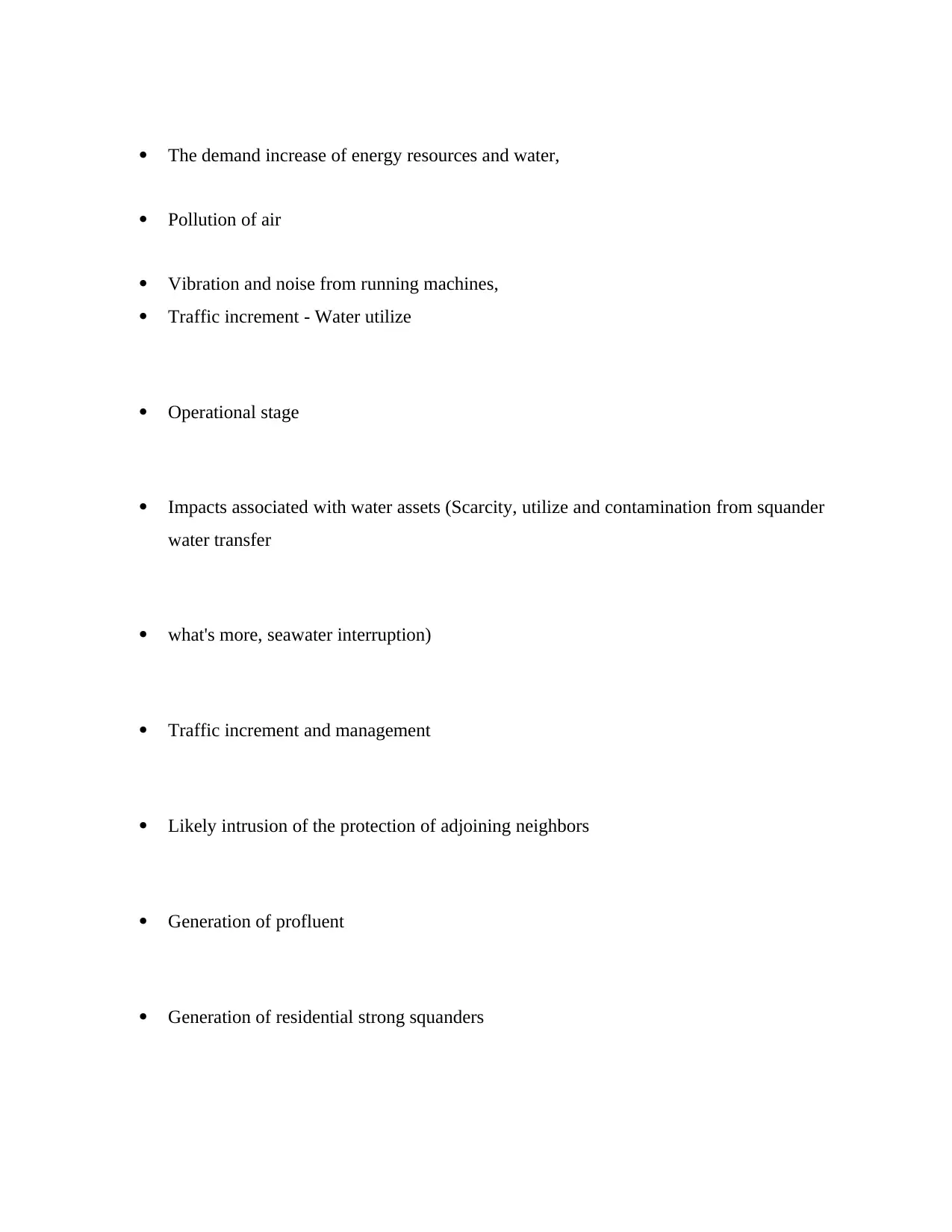
The demand increase of energy resources and water,
Pollution of air
Vibration and noise from running machines,
Traffic increment - Water utilize
Operational stage
Impacts associated with water assets (Scarcity, utilize and contamination from squander
water transfer
what's more, seawater interruption)
Traffic increment and management
Likely intrusion of the protection of adjoining neighbors
Generation of profluent
Generation of residential strong squanders
Pollution of air
Vibration and noise from running machines,
Traffic increment - Water utilize
Operational stage
Impacts associated with water assets (Scarcity, utilize and contamination from squander
water transfer
what's more, seawater interruption)
Traffic increment and management
Likely intrusion of the protection of adjoining neighbors
Generation of profluent
Generation of residential strong squanders
⊘ This is a preview!⊘
Do you want full access?
Subscribe today to unlock all pages.

Trusted by 1+ million students worldwide

Generation of E-squander
Increased utilization of vitality assets,
Safety perils radiating from potential for flame flare-ups, - Insecurity
Possible decommissioning impacts
1.4 Measures of mitigation on the project's negative impacts
The listed ecological effect mitigation measures explained below are proposed for construction
of residential houses all through the whole project cycle.
1.4.1 Project design and construction phase ( Bentley, Dittman and Whitten, 2000)
1.4.2 Change of User
The neighbors of the proposed site have different variety of type of houses ranging from low rise
to high rise buildings and have been effectively militated against pollution and thus
improvements could be made on their measures, the proposed projects are in accordance original
master plan. The proponent will obtain the change of user approval from the municipal
Government of New South Wales and the Ministry of Lands and planning.
Increased utilization of vitality assets,
Safety perils radiating from potential for flame flare-ups, - Insecurity
Possible decommissioning impacts
1.4 Measures of mitigation on the project's negative impacts
The listed ecological effect mitigation measures explained below are proposed for construction
of residential houses all through the whole project cycle.
1.4.1 Project design and construction phase ( Bentley, Dittman and Whitten, 2000)
1.4.2 Change of User
The neighbors of the proposed site have different variety of type of houses ranging from low rise
to high rise buildings and have been effectively militated against pollution and thus
improvements could be made on their measures, the proposed projects are in accordance original
master plan. The proponent will obtain the change of user approval from the municipal
Government of New South Wales and the Ministry of Lands and planning.
Paraphrase This Document
Need a fresh take? Get an instant paraphrase of this document with our AI Paraphraser

1.4.3 Sources of raw materials
The construction raw materials will be obtained by the contractor from sources that are
compliant with New South wales environmental protection authority (EPA) Regulations.
The quantity procured by the contractor will be sufficient for it to be used in planned
mechanisms only and reused as intended to reduce wastage.
The contractor usage of raw material should be appropriate to the level that would not
compromise the safety of construction of the residential houses
1.4.4 Impact of site preparation activities
• Rebuilding of physical environment by shredding off compacted domains and
landscaping.
1.4.5 Noise pollution
•Noise pollution to the two neighbors and laborers at the building site will be diminished
in the going with ways;
•Construction work and movement of raw materials will be limited to day time hours as it
were.
•Delivery of raw materials excluding ends of the week.
•Concrete mixers will be arranged far conceivable from neighboring properties
•The contractual worker will inform neighbors in composing before commencement of
the development with the objective that they are prepared psychologically in any event at
the very least of the two weeks early.
•Employees utilizing equipment that create peak sounds will be outfitted with ear covers
•The contractor must comply with to consent to Noise Regulations (Legal Notice No. 61
of 2009)
•The contracor will enroll the site as a workplace with the Directorate of Occupational
Health and Safety (DOHS
The contractor will utilize gear's with silencers in order to limit noise Emission
The construction raw materials will be obtained by the contractor from sources that are
compliant with New South wales environmental protection authority (EPA) Regulations.
The quantity procured by the contractor will be sufficient for it to be used in planned
mechanisms only and reused as intended to reduce wastage.
The contractor usage of raw material should be appropriate to the level that would not
compromise the safety of construction of the residential houses
1.4.4 Impact of site preparation activities
• Rebuilding of physical environment by shredding off compacted domains and
landscaping.
1.4.5 Noise pollution
•Noise pollution to the two neighbors and laborers at the building site will be diminished
in the going with ways;
•Construction work and movement of raw materials will be limited to day time hours as it
were.
•Delivery of raw materials excluding ends of the week.
•Concrete mixers will be arranged far conceivable from neighboring properties
•The contractual worker will inform neighbors in composing before commencement of
the development with the objective that they are prepared psychologically in any event at
the very least of the two weeks early.
•Employees utilizing equipment that create peak sounds will be outfitted with ear covers
•The contractor must comply with to consent to Noise Regulations (Legal Notice No. 61
of 2009)
•The contracor will enroll the site as a workplace with the Directorate of Occupational
Health and Safety (DOHS
The contractor will utilize gear's with silencers in order to limit noise Emission
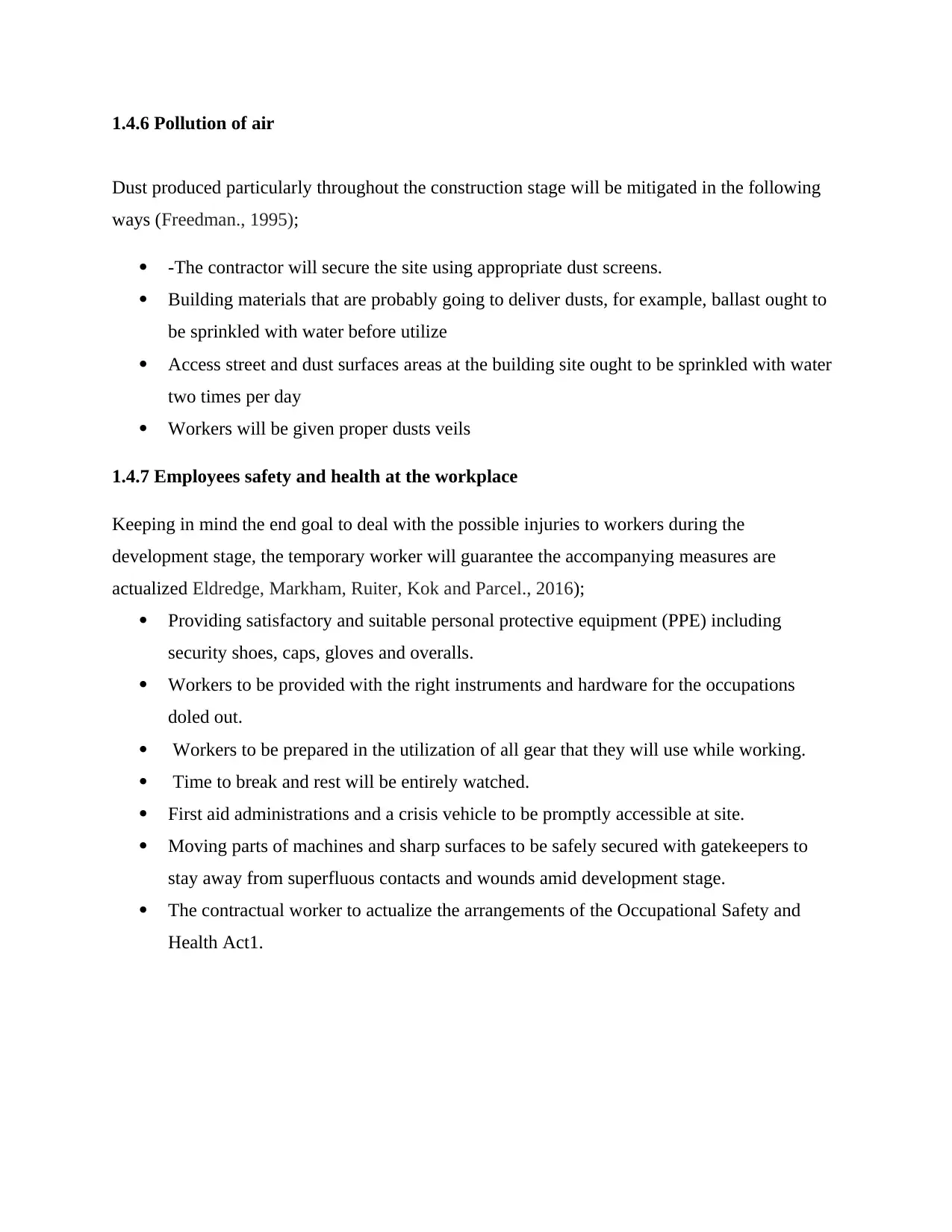
1.4.6 Pollution of air
Dust produced particularly throughout the construction stage will be mitigated in the following
ways (Freedman., 1995);
-The contractor will secure the site using appropriate dust screens.
Building materials that are probably going to deliver dusts, for example, ballast ought to
be sprinkled with water before utilize
Access street and dust surfaces areas at the building site ought to be sprinkled with water
two times per day
Workers will be given proper dusts veils
1.4.7 Employees safety and health at the workplace
Keeping in mind the end goal to deal with the possible injuries to workers during the
development stage, the temporary worker will guarantee the accompanying measures are
actualized Eldredge, Markham, Ruiter, Kok and Parcel., 2016);
Providing satisfactory and suitable personal protective equipment (PPE) including
security shoes, caps, gloves and overalls.
Workers to be provided with the right instruments and hardware for the occupations
doled out.
Workers to be prepared in the utilization of all gear that they will use while working.
Time to break and rest will be entirely watched.
First aid administrations and a crisis vehicle to be promptly accessible at site.
Moving parts of machines and sharp surfaces to be safely secured with gatekeepers to
stay away from superfluous contacts and wounds amid development stage.
The contractual worker to actualize the arrangements of the Occupational Safety and
Health Act1.
Dust produced particularly throughout the construction stage will be mitigated in the following
ways (Freedman., 1995);
-The contractor will secure the site using appropriate dust screens.
Building materials that are probably going to deliver dusts, for example, ballast ought to
be sprinkled with water before utilize
Access street and dust surfaces areas at the building site ought to be sprinkled with water
two times per day
Workers will be given proper dusts veils
1.4.7 Employees safety and health at the workplace
Keeping in mind the end goal to deal with the possible injuries to workers during the
development stage, the temporary worker will guarantee the accompanying measures are
actualized Eldredge, Markham, Ruiter, Kok and Parcel., 2016);
Providing satisfactory and suitable personal protective equipment (PPE) including
security shoes, caps, gloves and overalls.
Workers to be provided with the right instruments and hardware for the occupations
doled out.
Workers to be prepared in the utilization of all gear that they will use while working.
Time to break and rest will be entirely watched.
First aid administrations and a crisis vehicle to be promptly accessible at site.
Moving parts of machines and sharp surfaces to be safely secured with gatekeepers to
stay away from superfluous contacts and wounds amid development stage.
The contractual worker to actualize the arrangements of the Occupational Safety and
Health Act1.
⊘ This is a preview!⊘
Do you want full access?
Subscribe today to unlock all pages.

Trusted by 1+ million students worldwide
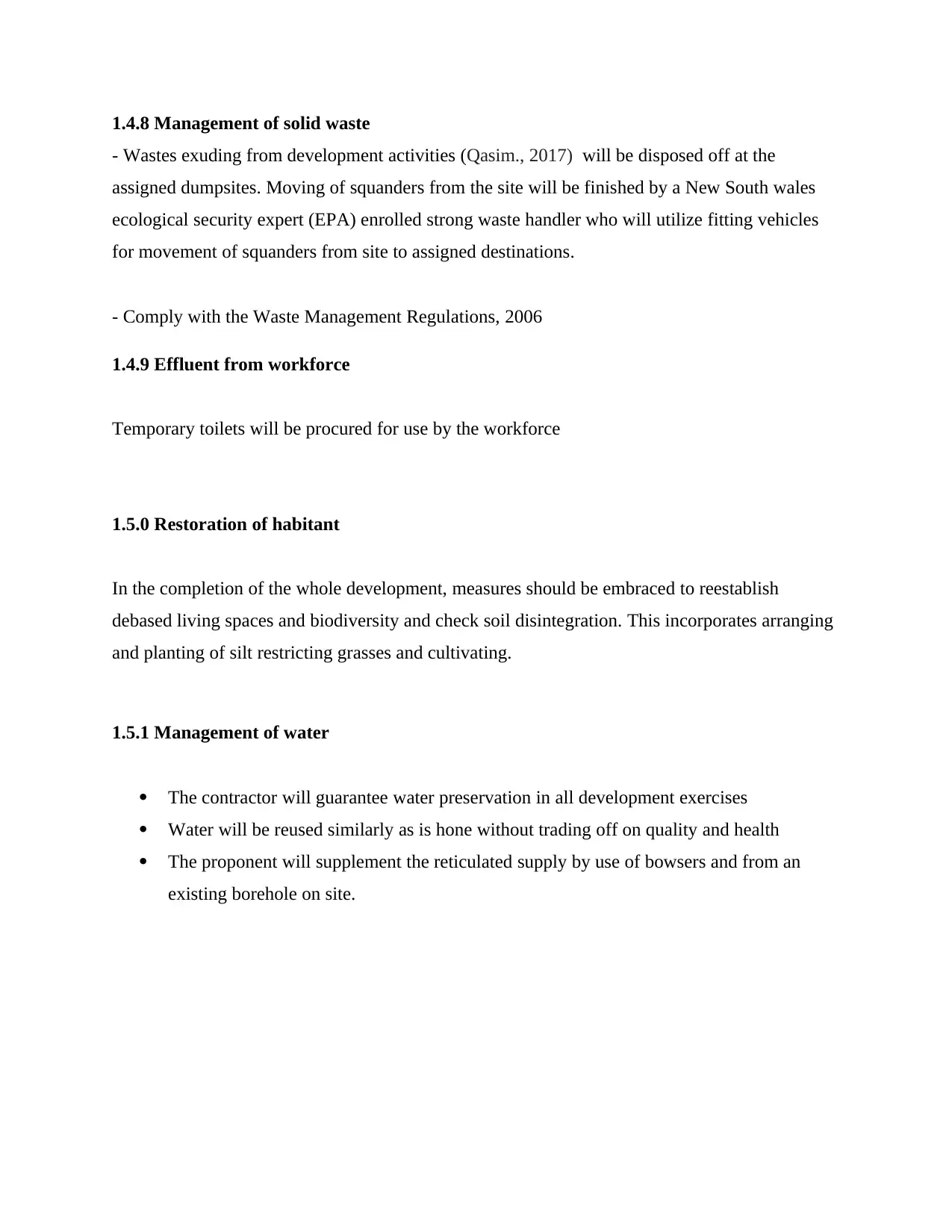
1.4.8 Management of solid waste
- Wastes exuding from development activities (Qasim., 2017) will be disposed off at the
assigned dumpsites. Moving of squanders from the site will be finished by a New South wales
ecological security expert (EPA) enrolled strong waste handler who will utilize fitting vehicles
for movement of squanders from site to assigned destinations.
- Comply with the Waste Management Regulations, 2006
1.4.9 Effluent from workforce
Temporary toilets will be procured for use by the workforce
1.5.0 Restoration of habitant
In the completion of the whole development, measures should be embraced to reestablish
debased living spaces and biodiversity and check soil disintegration. This incorporates arranging
and planting of silt restricting grasses and cultivating.
1.5.1 Management of water
The contractor will guarantee water preservation in all development exercises
Water will be reused similarly as is hone without trading off on quality and health
The proponent will supplement the reticulated supply by use of bowsers and from an
existing borehole on site.
- Wastes exuding from development activities (Qasim., 2017) will be disposed off at the
assigned dumpsites. Moving of squanders from the site will be finished by a New South wales
ecological security expert (EPA) enrolled strong waste handler who will utilize fitting vehicles
for movement of squanders from site to assigned destinations.
- Comply with the Waste Management Regulations, 2006
1.4.9 Effluent from workforce
Temporary toilets will be procured for use by the workforce
1.5.0 Restoration of habitant
In the completion of the whole development, measures should be embraced to reestablish
debased living spaces and biodiversity and check soil disintegration. This incorporates arranging
and planting of silt restricting grasses and cultivating.
1.5.1 Management of water
The contractor will guarantee water preservation in all development exercises
Water will be reused similarly as is hone without trading off on quality and health
The proponent will supplement the reticulated supply by use of bowsers and from an
existing borehole on site.
Paraphrase This Document
Need a fresh take? Get an instant paraphrase of this document with our AI Paraphraser
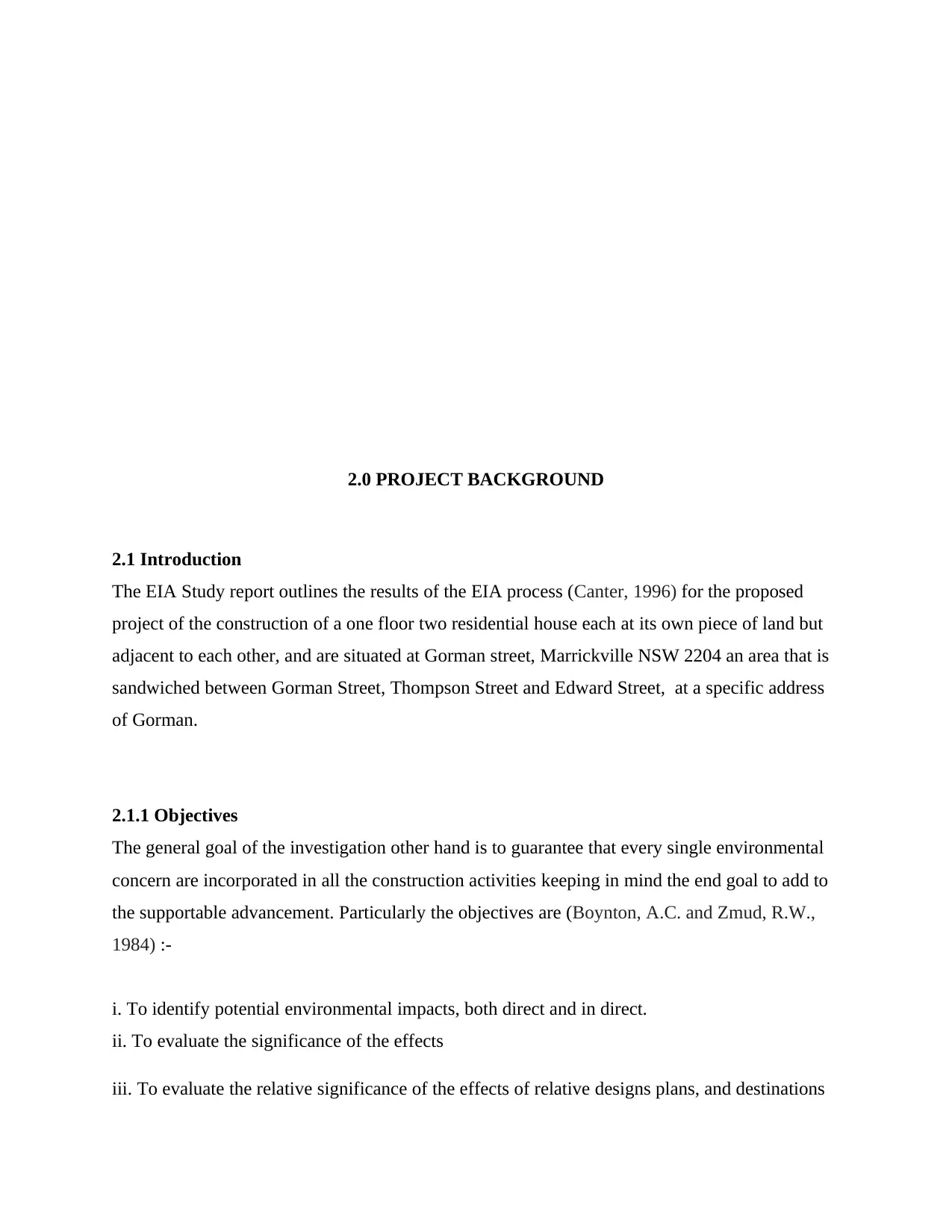
2.0 PROJECT BACKGROUND
2.1 Introduction
The EIA Study report outlines the results of the EIA process (Canter, 1996) for the proposed
project of the construction of a one floor two residential house each at its own piece of land but
adjacent to each other, and are situated at Gorman street, Marrickville NSW 2204 an area that is
sandwiched between Gorman Street, Thompson Street and Edward Street, at a specific address
of Gorman.
2.1.1 Objectives
The general goal of the investigation other hand is to guarantee that every single environmental
concern are incorporated in all the construction activities keeping in mind the end goal to add to
the supportable advancement. Particularly the objectives are (Boynton, A.C. and Zmud, R.W.,
1984) :-
i. To identify potential environmental impacts, both direct and in direct.
ii. To evaluate the significance of the effects
iii. To evaluate the relative significance of the effects of relative designs plans, and destinations
2.1 Introduction
The EIA Study report outlines the results of the EIA process (Canter, 1996) for the proposed
project of the construction of a one floor two residential house each at its own piece of land but
adjacent to each other, and are situated at Gorman street, Marrickville NSW 2204 an area that is
sandwiched between Gorman Street, Thompson Street and Edward Street, at a specific address
of Gorman.
2.1.1 Objectives
The general goal of the investigation other hand is to guarantee that every single environmental
concern are incorporated in all the construction activities keeping in mind the end goal to add to
the supportable advancement. Particularly the objectives are (Boynton, A.C. and Zmud, R.W.,
1984) :-
i. To identify potential environmental impacts, both direct and in direct.
ii. To evaluate the significance of the effects
iii. To evaluate the relative significance of the effects of relative designs plans, and destinations
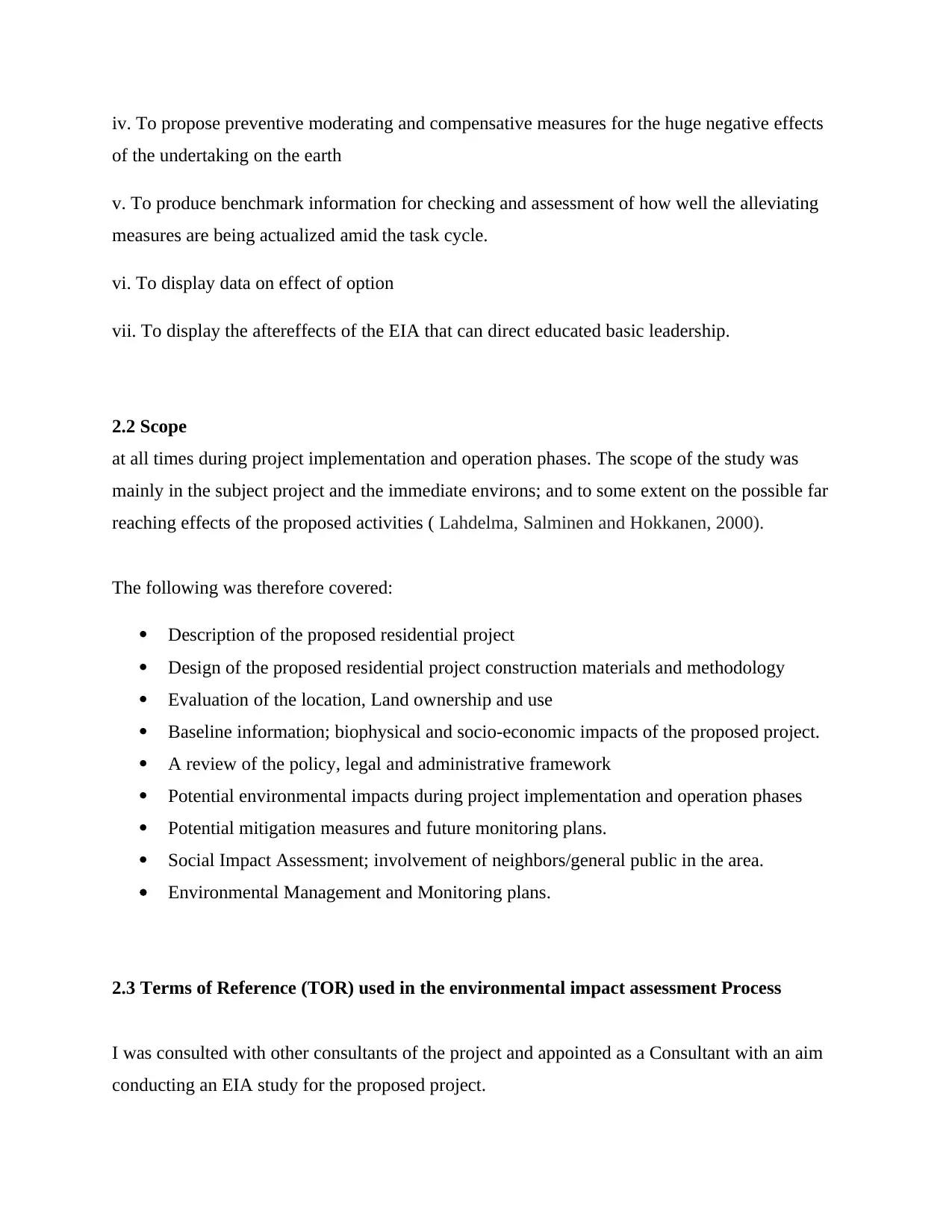
iv. To propose preventive moderating and compensative measures for the huge negative effects
of the undertaking on the earth
v. To produce benchmark information for checking and assessment of how well the alleviating
measures are being actualized amid the task cycle.
vi. To display data on effect of option
vii. To display the aftereffects of the EIA that can direct educated basic leadership.
2.2 Scope
at all times during project implementation and operation phases. The scope of the study was
mainly in the subject project and the immediate environs; and to some extent on the possible far
reaching effects of the proposed activities ( Lahdelma, Salminen and Hokkanen, 2000).
The following was therefore covered:
Description of the proposed residential project
Design of the proposed residential project construction materials and methodology
Evaluation of the location, Land ownership and use
Baseline information; biophysical and socio-economic impacts of the proposed project.
A review of the policy, legal and administrative framework
Potential environmental impacts during project implementation and operation phases
Potential mitigation measures and future monitoring plans.
Social Impact Assessment; involvement of neighbors/general public in the area.
Environmental Management and Monitoring plans.
2.3 Terms of Reference (TOR) used in the environmental impact assessment Process
I was consulted with other consultants of the project and appointed as a Consultant with an aim
conducting an EIA study for the proposed project.
of the undertaking on the earth
v. To produce benchmark information for checking and assessment of how well the alleviating
measures are being actualized amid the task cycle.
vi. To display data on effect of option
vii. To display the aftereffects of the EIA that can direct educated basic leadership.
2.2 Scope
at all times during project implementation and operation phases. The scope of the study was
mainly in the subject project and the immediate environs; and to some extent on the possible far
reaching effects of the proposed activities ( Lahdelma, Salminen and Hokkanen, 2000).
The following was therefore covered:
Description of the proposed residential project
Design of the proposed residential project construction materials and methodology
Evaluation of the location, Land ownership and use
Baseline information; biophysical and socio-economic impacts of the proposed project.
A review of the policy, legal and administrative framework
Potential environmental impacts during project implementation and operation phases
Potential mitigation measures and future monitoring plans.
Social Impact Assessment; involvement of neighbors/general public in the area.
Environmental Management and Monitoring plans.
2.3 Terms of Reference (TOR) used in the environmental impact assessment Process
I was consulted with other consultants of the project and appointed as a Consultant with an aim
conducting an EIA study for the proposed project.
⊘ This is a preview!⊘
Do you want full access?
Subscribe today to unlock all pages.

Trusted by 1+ million students worldwide
1 out of 21
Your All-in-One AI-Powered Toolkit for Academic Success.
+13062052269
info@desklib.com
Available 24*7 on WhatsApp / Email
![[object Object]](/_next/static/media/star-bottom.7253800d.svg)
Unlock your academic potential
Copyright © 2020–2025 A2Z Services. All Rights Reserved. Developed and managed by ZUCOL.